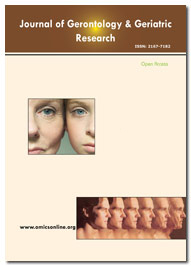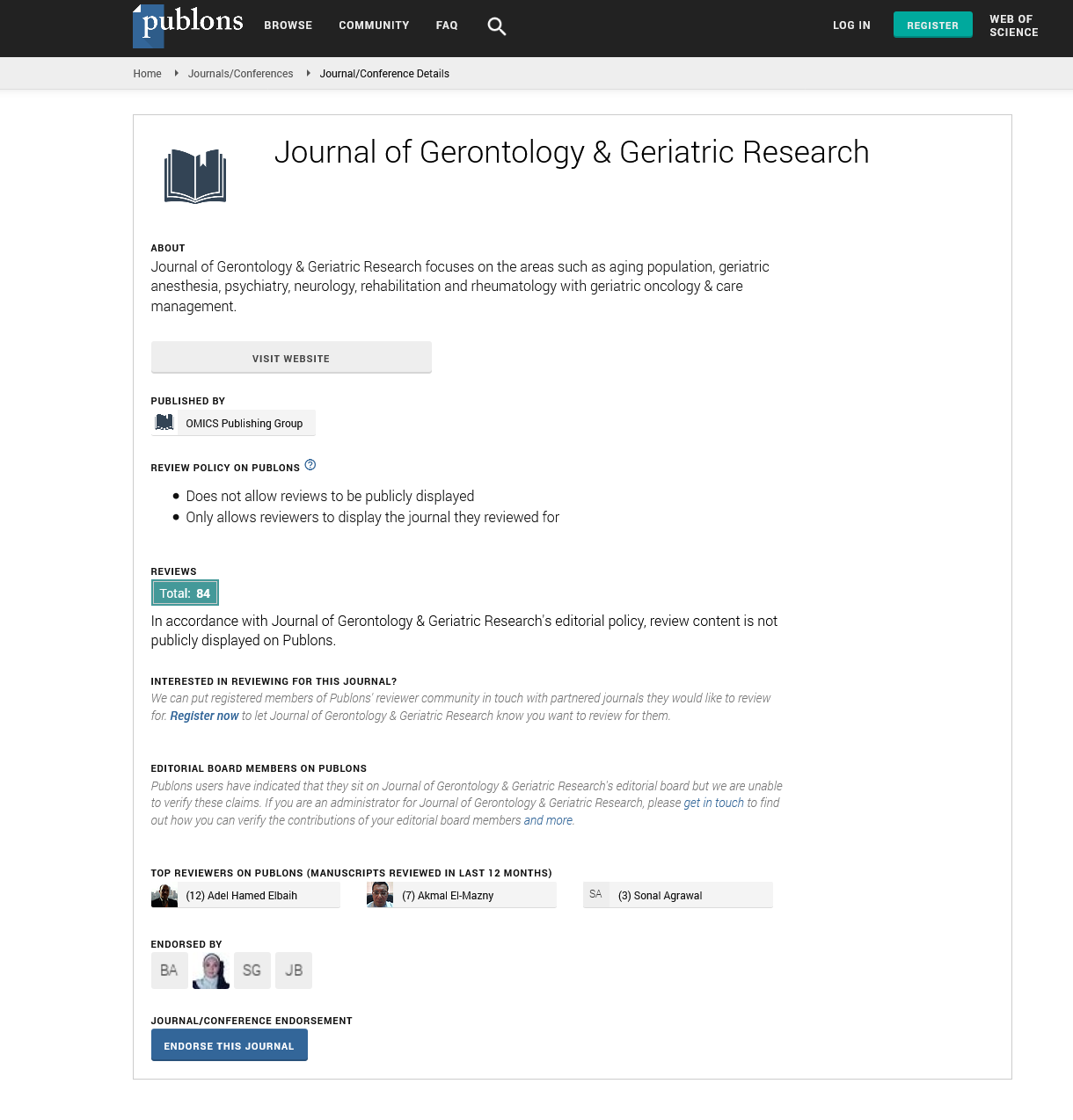Indexed In
- Open J Gate
- Genamics JournalSeek
- SafetyLit
- RefSeek
- Hamdard University
- EBSCO A-Z
- OCLC- WorldCat
- Publons
- Geneva Foundation for Medical Education and Research
- Euro Pub
- Google Scholar
Useful Links
Share This Page
Journal Flyer

Open Access Journals
- Agri and Aquaculture
- Biochemistry
- Bioinformatics & Systems Biology
- Business & Management
- Chemistry
- Clinical Sciences
- Engineering
- Food & Nutrition
- General Science
- Genetics & Molecular Biology
- Immunology & Microbiology
- Medical Sciences
- Neuroscience & Psychology
- Nursing & Health Care
- Pharmaceutical Sciences
Opinion - (2024) Volume 13, Issue 5
Technology and Aging: Assistive Devices and Digital Health Interventions for Older Adults
Shane William*Received: 02-Oct-2024, Manuscript No. jggr-24-27667; Editor assigned: 04-Oct-2024, Pre QC No. P-27667; Reviewed: 17-Oct-2024, QC No. Q-27667; Revised: 23-Oct-2024, Manuscript No. R-27667; Published: 30-Oct-2024, DOI: 10.35248/2167-7182.2024.13.757
Introduction
In the modern era, technology plays a pivotal role in transforming healthcare and enhancing the quality of life for individuals across all age groups. Among the most significant beneficiaries of these advancements are older adults, who are increasingly utilizing assistive devices and digital health interventions to improve their well-being, maintain independence, and manage chronic health conditions. The global population is aging rapidly due to increasing life expectancy, and with this demographic shift comes the necessity to address the unique challenges faced by older adults. These challenges often include physical, cognitive, and emotional decline, which can hinder their ability to live independently, stay socially engaged, and access healthcare services.
Technological innovations such as wearable devices, smart home systems, telemedicine, mobile health applications, and Artificial Intelligence (AI) have emerged as powerful tools to support aging populations. These technologies offer a wide range of solutions, from fall detection and medication reminders to virtual healthcare consultations and cognitive training exercises. Not only do these devices and interventions help older adults age more comfortably, but they also promote greater autonomy and self-management of health, ultimately enhancing their overall quality of life. This article will explore the various assistive devices and digital health interventions designed to address the needs of older adults. It will examine how these technologies work, their benefits, challenges, and potential future developments, as well as the impact they have on aging individuals, caregivers, and the healthcare system as a whole. Through an in-depth analysis, the article will provide a comprehensive understanding of how technology is reshaping aging and healthcare in the 21st century [1].
Description
The global population is aging at an unprecedented rate. According to the United Nations, the number of people aged 60 or older is projected to more than double by 2050, reaching 2.1 billion. This demographic shift presents several challenges, including increasing healthcare costs, a greater burden on informal caregivers, and the need for more specialized care services. Additionally, older adults are more susceptible to chronic conditions such as arthritis, cardiovascular disease, diabetes, and dementia, which require ongoing monitoring and management. As a result, there is a growing demand for innovative solutions that can help older adults live independently for longer, manage their health effectively, and stay connected to their communities [2]. Technology offers a promising avenue for addressing these needs, providing both practical assistance and improving healthcare delivery.
Wearable devices, such as smartwatches and fitness trackers, are revolutionizing the way older adults monitor their health. These devices can track various health metrics like heart rate, physical activity, sleep patterns, and even blood oxygen levels. Some wearables also feature fall detection, which automatically alerts caregivers or emergency services if the user experiences a fall. For older adults with chronic conditions, wearables can offer real-time data that is valuable for disease management, particularly for conditions like diabetes or hypertension.
Smart home devices can make living spaces safer and more accessible for older adults. Automated systems for lighting, heating, and security can be controlled remotely or through voice commands, making them particularly useful for individuals with mobility impairments [3]. Smart home technology can also assist with medication management through reminders and automated dispensers, helping to reduce the risk of missed doses. Mobility aids, such as wheelchairs, walkers, and scooters, have become more advanced with the integration of technology. Modern mobility aids are often equipped with sensors that assist with navigation, detect obstacles, and even provide stability. For example, powered wheelchairs and scooters can be controlled by joysticks, voice commands, or even eye-tracking devices, allowing users to move around more easily and safely.
Assistive technology has significantly advanced in the realm of sensory aids. For individuals with hearing loss, hearing aids have become more discreet and effective, with digital models that can adjust sound levels automatically based on the environment. Similarly, for those with vision impairments, advancements in optical technology, such as smart glasses and screen readers, are improving accessibility and quality of life. Telemedicine and telehealth services have become more prominent in recent years, especially in the wake of the COVID-19 pandemic. These digital healthcare solutions allow older adults to consult with healthcare providers remotely, reducing the need for in-person visits. Telemedicine offers the convenience of home-based healthcare for individuals with mobility limitations, chronic conditions, or those living in rural areas with limited access to medical facilities [4].
Mobile health apps have gained popularity as tools for managing chronic conditions, improving mental health, and promoting wellness. These apps enable users to track their symptoms, receive medication reminders, and access health resources. For example, older adults can use apps for managing diabetes or heart disease by inputting daily blood sugar levels or blood pressure readings, which can be shared with healthcare providers in real-time. Cognitive decline is a major concern for aging individuals, particularly those at risk for Alzheimer's disease and other forms of dementia. Digital interventions designed to stimulate cognitive function, such as brain games, memory exercises, and virtual reality programs, are becoming increasingly popular. These tools provide older adults with interactive and engaging ways to maintain mental acuity and manage cognitive decline. Additionally, mental health interventions, including teletherapy and online counseling services, are helping older adults address issues like depression, anxiety, and loneliness, which can be exacerbated by aging [5].
Artificial intelligence and robotics are playing a key role in enhancing the care of older adults. AI-driven applications are being used to personalize care plans, predict health issues before they become severe, and automate certain aspects of caregiving. Robots designed to assist with daily tasks, provide companionship, or even assist with mobility are also showing promise in improving the lives of older adults. The integration of assistive devices and digital health interventions provides numerous benefits for older adults.
Conclusion
Technology has the potential to transform the lives of older adults by enabling them to live more independently, manage their health more effectively, and remain engaged with their communities. Assistive devices and digital health interventions are offering practical solutions to the challenges posed by aging, from mobility aids and wearable devices to telehealth services and AI-powered healthcare tools. These technologies not only improve the quality of life for older adults but also provide significant benefits for caregivers and healthcare systems, offering more efficient and personalized care.
Acknowledgement
None.
Conflict of Interest
None.
References
- Vallée A. Envisioning the Future of Personalized Medicine: Role and Realities of Digital Twins. J Med Int Res. 2024;26:e50204.
- Kawarase IV MA, Anjankar A. Dynamics of metaverse and medicine: A review article. Cureus. 2022;14.
- Lewis KO, Popov V, Fatima SS. From static web to metaverse: Reinventing medical education in the post-pandemic era. Ann Med. 2024;56:2305694.
- Wang Y, Li C, Qu L, Cai H, Ge Y. Application and challenges of a metaverse in medicine. Front Robot AI. 2023;10:1291199.
- Guze PA. Using technology to meet the challenges of medical education. Trans Am Clin Climatol Assoc. 2015;126:260.
Google Scholar, Crossref, Indexed at
Google Scholar, Crossref, Indexed at
Google Scholar, Crossref, Indexed at
Google Scholar, Crossref, Indexed at
Citation: William S (2024). Technology and Aging: Assistive Devices and Digital Health Interventions for Older Adults. J Gerontol Geriatr Res. 13: 757.
Copyright: © 2024 William S. This is an open-access article distributed under the terms of the Creative Commons Attribution License, which permits unrestricted use, distribution, and reproduction in any medium, provided the original author and source are credited.

